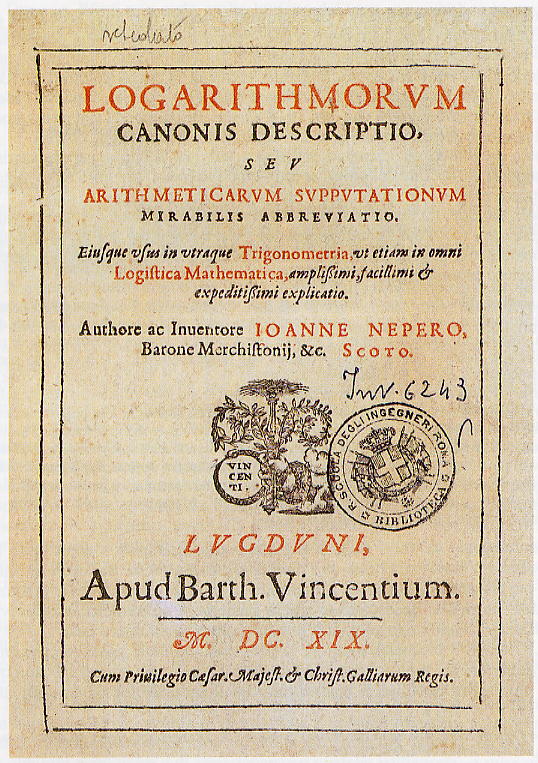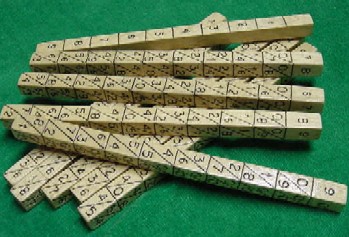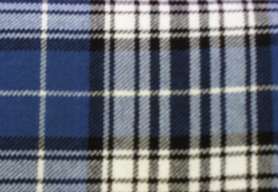Tales of Statisticians
John Napier
1550 - 4 April 1617Statistics throughout its history has been constrained and shaped by the difficulty of calculating probabilities. John Napier was responsible for not one but two advances in the art of calculating. His contribution led to the tables of Kepler, and thence to the laws of Newton. Napier's instrumentalities conferred precision; in the end, they helped modern science to emerge from ancient science.
Napier was born into an old and respected Scottish family, which fully maintained its position in his own time (his father Archibald would be knighted in 1565 and made Master of the Mint, the post later held by Newton, in 1582). John entered St Andrews in 1563, at the remarkable age of 13, but never graduated. At the death of his mother, which occurred not long afterward, he instead continued his studies somewhere in Europe. In due course he succeeded to the position of Laird of Merchiston, the estate near Edinburgh which his clan had possessed since the 1430's. It was made over to him in 1572, and in 1574, being then 24, he took up residence there, in a newly erected home.
Napier was an enthusiastic overseer of agriculture on the Merchiston estate, and seems to have experimented with different soil treatments in ways that might have attracted the interest of Ronald A Fisher. In the intervals of that enthusiasm (the steady sound of the mill cascade near his study window was conducive, but the occasional clack of the mill itself, less so), Napier made an important practical discovery in another incipiently statistical area. The root idea is this: Rather than multiplying numbers, which is arduous, it suffices to add their exponents, and then look up the result.
The idea is that between 2*2 = 4 and 2*3 = 8, that is, between the exponents 2 and 3 of the base number 2, there lie an infinity of intervening numbers (2.1, 2.2, and so on, as finely divided as one cares to make them), which are the exponents of the numbers between 4 and 8 in that particular (base 2) system. This discovery he published in Latin in the year 1614 (the copy below is not a first edition):
An English translation appeared shortly afterward. Napier proceeded to develop the first mechanical calculator, consisting of a set of ivory bars (from their color, irreverantly called "Napier's bones"),
which might be aligned in various ways to permit calculations to be read directly from them.
This was first published in 1617, the year of Napier's death. (Napier's rods were not, as one might have thought, the ancestor of the later slide rule, which flowed rather from the logarithmic principle itself. The slide rule permits logarithmically ruled scales to be juxtaposed so as, in effect, to add the logarithms of two numbers without having to actually look up the logarithms, and then compute the equivalent of the result (the antilogarithm).
Napier's logarithms were not originally put forward in what proved to be their most convenient form. It was due to Henry Briggs, Professor of Geometry in Gresham College, who first made the four-day trip from London to Edinburgh in 1615, that the base 10 logarithms were properly defined (Napier admitted, during their first correspondence, that the use of base 10 had already occurred to him). The remark made by Briggs on first meeting Napier face to face is immortal in the history of mathematics, and may be reproduced here:
"My Lord, I have undertaken this long journey purposely to see your person, and to know by what engine of wit or ingenuity you came first to think of this most excellent help unto astronomy, viz. the Logarithms; but, my Lord, being by you found out, I wonder nobody else found it out before, when now known it is so easy."
Everything is easy once you see it. The trick is to see it. Briggs generously became Napier's collaborator and indeed publicist. He undertook to calculate a table of logarithms, a task for which Napier himself, with his duties of estate oversight, and with his already failing health (he died before he and Briggs could meet a third time) had not the requisite leisure or energy. The rest, as they say, is history.
We may end this notice with a tribute to Napier's lairdship, in the form of the "ancient" version of the Clan Napier tartan, the only one of all the Highland tartans to inhabit the blue portion of the spectrum -
Those with a bit of imagination may like to see, in the closely spaced bars of the tartan, the nicely juxtaposed bars of ivory in Napier's calculating machine.
Briggs refined Napier's logarithms, the slide rule (at least for hurried engineers) obsoleted Briggs's tables, and the electronic calculator has now superseded the slide rule. The base 10 form of logarithms has meanwhile been found less elegant, as a notation for natural growth processes, than the irrational base e form (respectfully, but not accurately, called "Napierian" logarithms).
None of which reduces, indeed, all of which underscores, the debt of mathematics, and all who make use of it, to the man who (except in his Latin publications) would have spelled himself Jhone Neper.
Almost needless to add, as a reward for his hours of secluding himself in his study by the mill, Napier came to be regarded by the locals as a sorcerer. Had he spent more time outdoors, in such healthy and straightforward pastimes as beating the backs of the peasants with his stick, he would probably have had a more accepting reputation among the simples of Merchiston. Napier's true fame rests with those who understand what numbers - accurate numbers, fast numbers - have to offer to the understanding of the world.
Statistics is Copyright © 2001- by E Bruce Brooks
4 Sept 2004 / Contact The Project / Exit to Statistics Page




